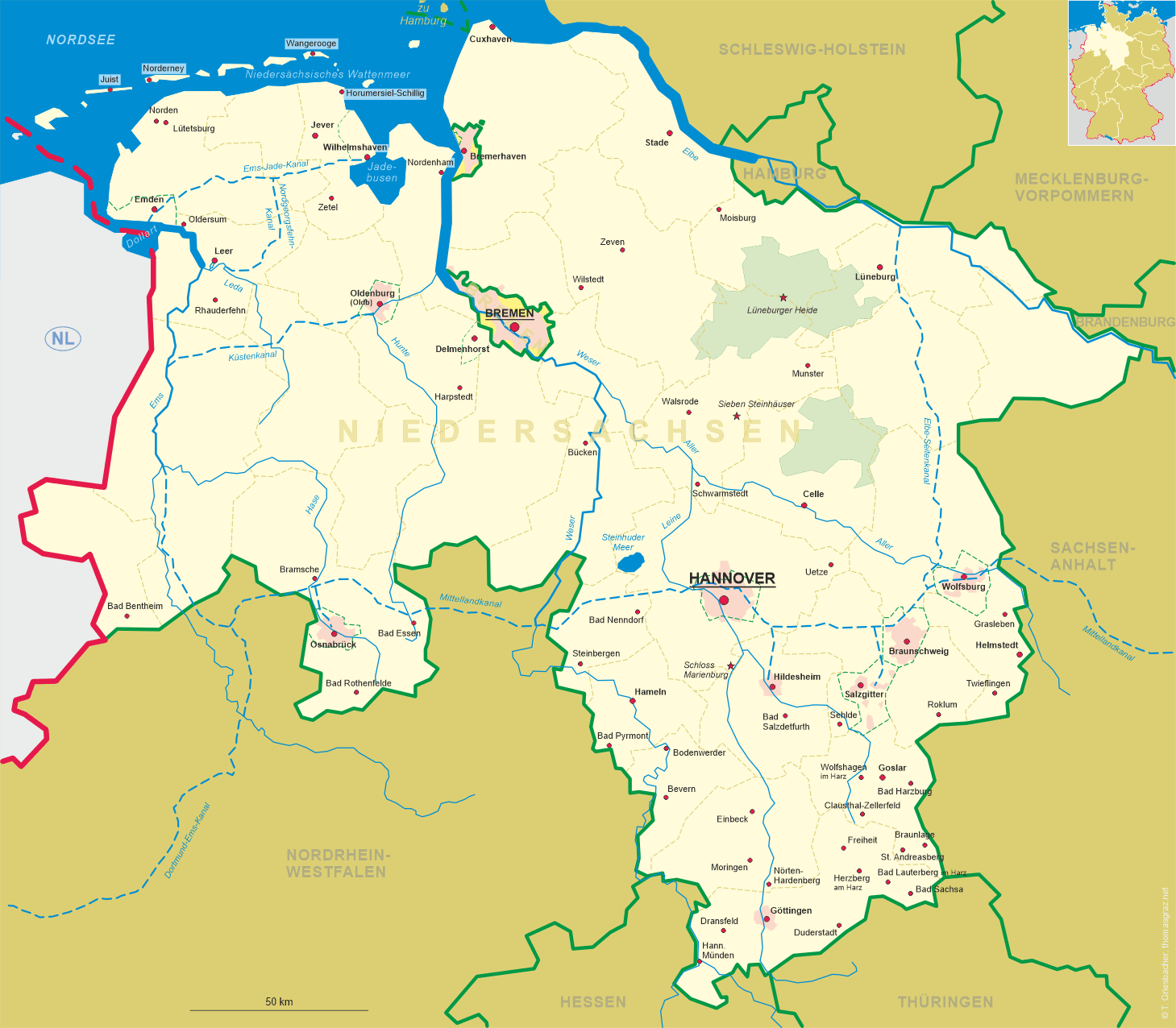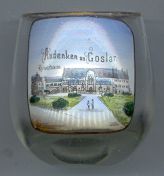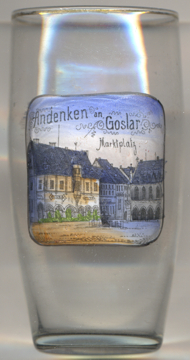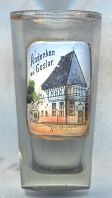| DEUTSCHLAND
| GERMANY
|
| Bundesland: Niedersachsen
| Lower Saxony
|
| Landkreis: Goslar
|
|
map →

Goslar
• lv: Goslara
• lt: Goslaras
• el: Γκόσλαρ
• be, bg, mk, ru, sr, uk: Гослар
Goslar is situated at an elevation of 260 m at the river Gose, a tributary of the river Oker, at the northern fringe of the
Harz mountain region in southern Lower Saxony.
 Goslar was founded in AD 922 by Emperor Heinrich I. The town soon gained importance due to the prosperous silver mines in the Rammelberg.
Emperor Heinrich II founded the famous
Goslar was founded in AD 922 by Emperor Heinrich I. The town soon gained importance due to the prosperous silver mines in the Rammelberg.
Emperor Heinrich II founded the famous  Kaiserpfalz (Imperial residence)
[left, o. 1787] in the 11th century.
It was enlarged by Emperor Heinrich III, who made it one of his favourite residences. Goslar thus became one of the most important places in the
Empire; it was the site of 23 Imperial diets, and about a hundred times the town was visited by the German kings and emperors.
The last German king to visit Goslar was Wilhelm of Holland in 1253.
Goslar became an important trading town and obtained the status of a Free Imperial City in 1290/1340.
Mining flourished in the 15th century, but the wealth of the town declined when the duchy of Braunschweig-Wolfenbüttel regained
control of the mines in 1525/1527. In 1802 Goslar lost its status as Free Imperial City and became part of Prussia.
The Kaiserpfalz was thoroughly renovated in 1868 1897.
The mines in the Rammelsberg, once one the world's most profitable deposits of copper, lead and zink, were closed in 1988.
The historic town centre and the mines in the Rammelsberg were listed by the UNESCO as a World Cultural Heritage in 1992
(see also list of other UNESCO heritage sites).
Kaiserpfalz (Imperial residence)
[left, o. 1787] in the 11th century.
It was enlarged by Emperor Heinrich III, who made it one of his favourite residences. Goslar thus became one of the most important places in the
Empire; it was the site of 23 Imperial diets, and about a hundred times the town was visited by the German kings and emperors.
The last German king to visit Goslar was Wilhelm of Holland in 1253.
Goslar became an important trading town and obtained the status of a Free Imperial City in 1290/1340.
Mining flourished in the 15th century, but the wealth of the town declined when the duchy of Braunschweig-Wolfenbüttel regained
control of the mines in 1525/1527. In 1802 Goslar lost its status as Free Imperial City and became part of Prussia.
The Kaiserpfalz was thoroughly renovated in 1868 1897.
The mines in the Rammelsberg, once one the world's most profitable deposits of copper, lead and zink, were closed in 1988.
The historic town centre and the mines in the Rammelsberg were listed by the UNESCO as a World Cultural Heritage in 1992
(see also list of other UNESCO heritage sites).
 Glass no. 3800 [near left] shows a view of the
Glass no. 3800 [near left] shows a view of the
 market square. The old
market square. The old
 town hall [right] was originally built in the mid
15th century and was continually modified and enlarged throughout the subsequent 400 years. The walls, ceiling
and window niches of the so-called Huldigungssaal ('Homage Hall') are decorated by panel paintings of the early
15th century (1501–1515) attributed to an unknown painter today referred to as the 'Master of the Goslar Sibyls.
town hall [right] was originally built in the mid
15th century and was continually modified and enlarged throughout the subsequent 400 years. The walls, ceiling
and window niches of the so-called Huldigungssaal ('Homage Hall') are decorated by panel paintings of the early
15th century (1501–1515) attributed to an unknown painter today referred to as the 'Master of the Goslar Sibyls.
The  Kaiserworth [left] was built in 1484 for the robe tailors' guild, using
the foundations of a former guildhouse of 1274. The medieval association of long-distance and wholesale merchants in Goslar
called itself "Worthgilde" and was the most important guild in Goslar. Today, the historic building is used as a hotel.
Kaiserworth [left] was built in 1484 for the robe tailors' guild, using
the foundations of a former guildhouse of 1274. The medieval association of long-distance and wholesale merchants in Goslar
called itself "Worthgilde" and was the most important guild in Goslar. Today, the historic building is used as a hotel.
[https://www.goslar.de/tourismus/geschichte-erleben/rund-um-den-markt;
https://de.wikipedia.org/wiki/Meister_der_Goslarer_Sibyllen;
https://de.wikipedia.org/wiki/Kaiserworth]
 The
The  Brusttuch [near left, no. 1802], an old patrician house built in 1521, is one of the most beautiful half-timbered houses in Goslar.
Today the building is used as a restaurant and hotel.
Brusttuch [near left, no. 1802], an old patrician house built in 1521, is one of the most beautiful half-timbered houses in Goslar.
Today the building is used as a restaurant and hotel.
![[scale]](lineal.jpg)


 Goslar was founded in AD 922 by Emperor Heinrich I. The town soon gained importance due to the prosperous silver mines in the Rammelberg.
Emperor Heinrich II founded the famous
Goslar was founded in AD 922 by Emperor Heinrich I. The town soon gained importance due to the prosperous silver mines in the Rammelberg.
Emperor Heinrich II founded the famous  Kaiserpfalz
Kaiserpfalz Glass no. 3800 [near left] shows a view of the
Glass no. 3800 [near left] shows a view of the
 market
market town hall
town hall Kaiserworth [left] was built in 1484 for the robe tailors' guild, using
the foundations of a former guildhouse of 1274. The medieval association of long-distance and wholesale merchants in Goslar
called itself "Worthgilde" and was the most important guild in Goslar. Today, the historic building is used as a hotel.
Kaiserworth [left] was built in 1484 for the robe tailors' guild, using
the foundations of a former guildhouse of 1274. The medieval association of long-distance and wholesale merchants in Goslar
called itself "Worthgilde" and was the most important guild in Goslar. Today, the historic building is used as a hotel.
 The
The  Brusttuch [near left, no. 1802], an old patrician house built in 1521, is one of the most beautiful half-timbered houses in Goslar.
Today the building is used as a restaurant and hotel.
Brusttuch [near left, no. 1802], an old patrician house built in 1521, is one of the most beautiful half-timbered houses in Goslar.
Today the building is used as a restaurant and hotel.
![[scale]](lineal.jpg)